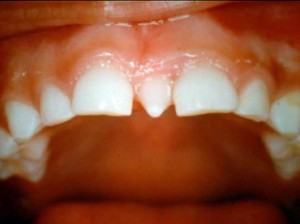Common behaviors seen in children and adults with jaw deficits and subsequent speech and feeding disorders are that of maladaptive oral habits. Such habits include jaw clenching and teeth grinding (bruxism), excessive mouthing of objects, thumb and finger sucking, tongue sucking, lip chewing, nail biting, and extended bottle and pacifier use. These habits, when excessive or are continued past appropriate developmental necessity, can lead to poor dental health, be socially stigmatizing, and inhibit the development of speech clarity. Continue reading
Category Archives: Baby Teeth
Oral pathology in newborn infants
1)Â Â Â Â Â Epstein pearls:
They are whitish yellow nodules found in the midline of your infant’s palate (the roof of your mouth). The nodules are around 1 to 3mm in size. Do not worry as they are just a result of epithelial tissues trapped during the fusion of the palate. There is no treatment needed if your baby has Epstein pearls as they will disappear within 1 to 2 weeks of birth. Continue reading
Neonatal teeth
 WHAT ARE NEONATAL AND NATAL TEETH?
WHAT ARE NEONATAL AND NATAL TEETH?
Natal teeth are teeth which are present in the oral cavity at the time of birth where as neonatal teeth erupt during 30 days of life. Primary tooth normally starts erupting at about 6 months of age. Natal teeth might resemble normal primary teeth in terms of size and shape. However, they can be smaller, yellowish and root formation of the teeth may not be completed/total absence during the time of eruption. This lack of root development can cause  mobility of the neonatal tooth. Continue reading
Extraction of baby teeth
1. Why extract a baby tooth?
Choosing between extraction and filling or conservation is a very common decision that both dentists and patients have to take every day. With adults the decision making is much easier, if the tooth is restorable and the patient can pay for the treatment then we simply conserve the tooth. If the patient is a child then the process of decision making is much harder as many factors affect the selection of the treatment plan that the dentist have to follow. Continue reading
Delayed eruption of teeth Part 6
DTE with no obvious developmental defect in the affected tooth or teeth on the radiograph
In this case, root development (biologic eruption status), tooth position, and physical obstruction (radiographically evident or not) should be evaluated. Continue reading
Delayed eruption of teeth Part 5
DTE is often seen in the region of the maxillary canines. The maxillary canine develops high in the maxilla and is the only tooth that must descend more than its length to reach its position in the dental arch. When pathologic conditions are ruled out, the etiology of DTE of the canines has been suggested to be multifactorial. Specifically, 3 factors have been proposed for consideration: Continue reading
Delayed eruption of teeth Part 4
Other systemic conditions associated with impairment of growth, such as anemia (hypoxic hypoxia, histotoxic hypoxia, and anemic hypoxia) and renal failure, have also been correlated with DTE and other abnormalities in dentofacial development. Continue reading
Delayed eruption of teeth Part 3
Mucosal barrier has also been suggested as an etiologic factor in DTE. Any failure of the follicle of an erupting tooth to unite with the mucosa will entail a delay in the breakdown of the mucosa and constitute a barrier to emergence. Histologic studies have shown differences in the submucosa between normal tissues and tissues with a history of trauma or surgery. Gingival hyperplasia resulting from various causes (hormonal or hereditary causes, vitamin C deficiency, drugs such as phenytoin) might cause an abundance of dense connective tissue or acellular collagen that can be an impediment to tooth eruption. Continue reading
The Extra Tooth!
Did you ever wonder why do you find some children with a small extra tooth in between their permanent incisors?
This small little tooth is called Supernumerary Tooth.
Â
A Supernumerary Tooth is one that is additional to the normal series and can be found in almost any region of the dental arch. Most supernumerary teeth are located in the upper incisors region commonly known as mesiodens. Their presence may give rise to a variety of clinical problems in the future for children.
Delayed eruption of teeth Part 2
Primary or idiopathic failure of eruption is a condition described by Profitt and Vig, whereby nonankylosed teeth fail to erupt fully or partially because of malfunction of the eruption mechanism. This occurs even though there seems to be no barrier to eruption, and the phenomenon is considered to be due to a primary defect in the eruptive process. Terms such as arrested eruption and noneruption have been used interchangeably to describe a clinical condition that might have represented ankylosis, impaction, or idiopathic failure of eruption. These terms refer more to the pathogenesis of DTE than to the benchmarks that define DTE. Continue reading

